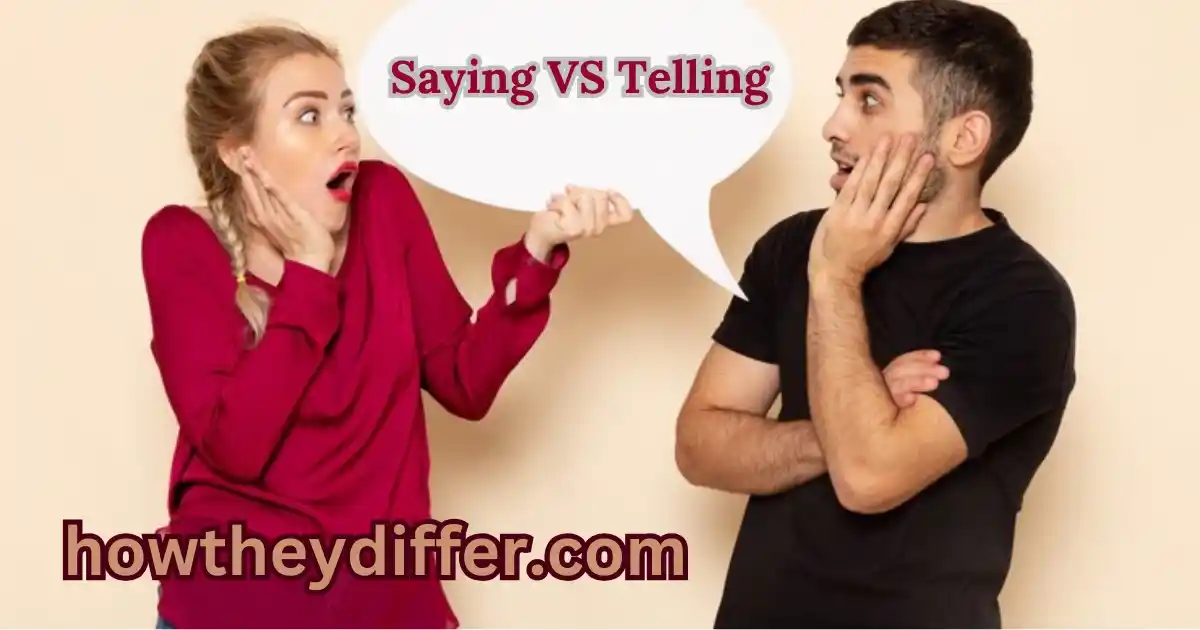Have you ever heard someone say, “Don’t just say it, tell me!”? It might seem confusing since “say” and “tell” seem pretty similar. We use both words when we talk, right? You’re right! But there’s a small but important difference between saying and telling.
Understanding this difference can make your conversations clearer and help you understand others better. It’s like knowing when to use a fork or a spoon at dinner – both help you eat, but they work best for different foods.
In this article, we’ll learn the difference between saying and telling with easy-to-understand examples. Think of it as a guide to help you use these words correctly, just like a guide to learning a new game!
Understanding the Difference Between Saying and Telling
Let’s start with what makes saying and telling different. “Saying” is like simply making a sound with words. It’s about expressing something, whether it’s an idea, a feeling, or just a random sound. Imagine a parrot repeating a word – it’s “saying” the word, but it doesn’t really understand what it means.
“Telling,” on the other hand, is about giving information to someone. It’s like sharing a secret or giving directions. When you “tell” someone something, you want them to know or understand something specific.
Think of it this way:
- Saying: “It’s raining.”
- Telling: “I’m going to the store.”
In the first example, you’re simply stating a fact about the weather. In the second, you’re providing information about your plans.
How to Use “Say”
“Say” is often used when:
- You’re speaking words: “She said ‘hello’ when she answered the phone.”
- You’re expressing yourself: “He said he was feeling sad.”
- You’re quoting someone: “The teacher said, ‘Please open your books.'”
“Say” is usually followed by:
- The words someone spoke: “He said ‘good morning.'”
- A clause starting with “that”: “She said that she was tired.”
How to Use “Tell”
“Tell” is often used when:
- You’re giving information: “He told me his name.”
- You’re instructing someone: “She told him to be quiet.”
- You’re sharing a story: “Grandma told us a fairytale.”
“Tell” is usually followed by:
- The person you’re informing: “Tell me your secret.”
- An object and then the person: “Tell him the truth.”
- Someone to do something: “Tell her to call me later.”
To make it even clearer, let’s look at these examples in a table:
| Feature | Saying | Telling |
|---|---|---|
| Purpose | Expressing something general | Giving specific information |
| Focus | The words themselves | The message being conveyed |
| Example | He said the movie was good. | He told me the movie was about a superhero. |
Common Mistakes and How to Avoid Them
Even though we use “say” and “tell” all the time, it’s easy to get them mixed up. Here are some common mistakes people make:
- Using “say” when they should use “tell”: Incorrect: “She said me she was going to the party.” Correct: “She told me she was going to the party.”
- Forgetting to include the object with “tell”: Incorrect: “He told to wait here.” Correct: “He told me to wait here.”
To avoid these mistakes, remember this simple trick: “Tell” usually needs a person after it (the person being told). If you’re giving information to someone, you need to say who you’re giving it to!
Practicing the Difference
The best way to get better at using “say” and “tell” correctly is to practice! Try these exercises:
- Fill in the blanks:
- She ____ (said/told) that she liked ice cream.
- Can you ____ (say/tell) me the time?
- He ____ (said/told) “thank you” to the cashier.
- Write your own sentences:
- Write two sentences using “say” correctly.
- Write two sentences using “tell” correctly.
| Exercise | “Say” Example | “Tell” Example |
|---|---|---|
| Fill in the blanks | She said that she liked ice cream. | Can you tell me the time? |
| Write your own sentences | The dog said “woof!” | I told my friend a joke. |
Conclusion
Saying and telling are both about using words, but they have different purposes. “Saying” is about expressing something in general, while “telling” is about giving specific information to someone.
By paying attention to how these words are used, you can improve your communication skills and understand others better.
Remember the simple tips and examples we discussed, and soon you’ll be a pro at using “say” and “tell” correctly!
FAQs
Some of the frequently inquired questions regarding the differences between saying and telling are as follow:
What’s the main difference between saying and telling?
“Saying” emphasizes the words spoken, while “telling” focuses on communicating with a specific person or group.
Can “say” and “tell” be used interchangeably?
No, they serve different purposes. “Say” reports words; “tell” requires a recipient and often conveys a message.
When should I use “say” instead of “tell”?
Use “say” when quoting someone or reporting speech without emphasizing the listener.
Why does “tell” need a specific recipient?
“Tell” implies communication directed at someone, making a listener essential.
What’s a common mistake with “say” and “tell”?
A common mistake is using “say” when a recipient is needed or “tell” without mentioning a listener.
